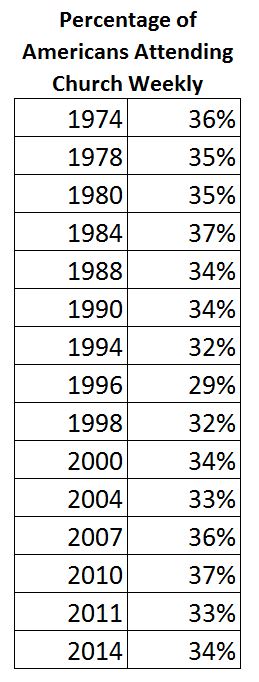Popular thought leaders increasingly point to the rising tide of “nones” as heralding the end of Christianity’s importance in America, despite evidence contradicting this fallacious narrative. The story goes that fewer young Americans buy into the exclusive truth claims of Christianity and have abandoned religion in droves, resulting in the swelling ranks of religiously unaffiliated “nones” across America.
Public Religion Research Institute CEO Robert P. Jones serves as an example of one public intellectual promoting this narrative. In his book The End of White Christian America published in 2016, Jones partially attributes the supposed death of “White Christian America” to the failure to accommodate young Americans’ shifting morals. As IRD contributor Derryck Green writes in his book review for Juicy Ecumenism:
Jones’ claims that the refusal to bend to cultural trends and accept gay marriage (which he labels anti-gay) puts the evangelical portion of White Christian America at odds with younger Americans (132-137). There’s a subtle suggestion that evangelicals should follow their mainline brethren and bend or reject traditional Christian biblical and theological teaching on marriage as a strategy to broaden its appeal to younger Americans.
Deeper analysis rebuts arguments like those advanced by Jones. Religious researcher Rodney Stark debunks several myths about “nones,” Millennials, and religion in his book The Triumph of Faith, which I recently reviewed.
Stark begins by refuting the claim Millennials’ Church attendance represents an unprecedented rejection of the Church. He concedes that “younger Americans are attending church less often than are older generations,” yet he denies this has resulted in lower overall church attendance.
 He says that younger Americans have “always” attended church less often than their elders. But “generation after generation,” they predictably start attending church more often as they get older and start families. Consequently church attendance has remained remarkably constant over the past three decades.
He says that younger Americans have “always” attended church less often than their elders. But “generation after generation,” they predictably start attending church more often as they get older and start families. Consequently church attendance has remained remarkably constant over the past three decades.
Furthermore, Stark clarifies the emergence of more “nones” in America. He says this represents nothing new or scary in the religious landscape (emphasis Stark’s):
Back in 1990 most Americans who seldom or never attended church still claimed a religious affiliation when asked to do so. Today, when asked their religious preference, instead of saying Methodist of Catholic, now a larger proportion of non-attenders say “none,” by which most seem to mean “no actual membership.” The entire change has taken place within the nonattending group, and the nonattending groups has not grown.
Stark also busts another myth: that young Evangelicals abandon the church because they are becoming more liberal. He notes that survey data show that generally “young evangelicals were as conservative, and sometimes more so, on major social issues.”
These findings jive with statistics released by the Barna Group in their newly published book, BarnaTrends 2017. Barna acknowledges that Millennials have become more progressive than their older counterparts, but that isn’t true within the Church. Religiously active Millennials remain ideologically firm and orthodox.
For example, Barna notes that younger American generations have overwhelmingly shifted toward supporting same-sex marriage. Yet practicing Millennials buck the trend.
“In the U.S., age has been and continues to be a defining fault line when it comes to same-sex marriage,” Barna explains. “Younger Christians, however, have more in common with the older counterparts in faith than they do with their peers in the general population.”
Furthermore, practicing Christian Millennials rank as the most concerned about the future of religious freedom of any demographic and the vast majority (91 percent) views their faith as “a force for good” in society. Nearly two-thirds of Millennials as a whole identify the Church as “a place to find answers to live a meaningful life.”
Perhaps this indicates why conservative churches are actually growing. One Canadian study, released in November 2016, demonstrated a link between church growth and the “conservative theological beliefs of their members and clergy,” as Emily McFarlan Miller reported for Religion News Service.
Stark notes in The Triumph of Faith that Evangelical denominations and nondenominational churches have experienced overwhelming growth in America during the past half century. These conservative churches have absorbed individuals driven away by Mainline Protestant denominations, which have experienced rapid declines in membership over the same period of time.
“The wreckage of former Mainline denominations is strewn upon the shoal of a modernist theology that began to dominate the Mainline seminaries early in the nineteenth century,” Stark writes.
These Mainline seminaries advocated for a radical reinterpretation of “outmoded” religion. As theologian Gary Dorrien summarized, religion needed to become “modern and progressive,” and moreover “the meaning of Christianity should be reinterpreted from the standpoint of modern knowledge and experience.”
The worldly wisdom advanced by the likes of Robert P. Jones asserting that the Church must compromise on its core theology in order to thrive has already been attempted and proven wrong. What Millennials want from the Church is not another voice echoing the liberal social gospel or postmodern sexual non-ethic.
In a culture that preaches anything but the Christian Gospel, Millennials thirst for churches that provide ageless truths revealing the meaning of life. Thus the Church need not fear the seeming growth of “nones” in America. This represents an opportunity rather than a danger, since it simply requires that the Church pursues its central mission to “make disciples of all nations” by preaching the Gospel.





Comment by HBE on February 21, 2017 at 11:55 am
Great clarification. Thanks for the article.
One nitpick. The word you wanted in your 8th paragraph is “jibe”. Not “jive”. 🙂
http://americanenglishdoctor.com/wordpress/jive-and-jibe